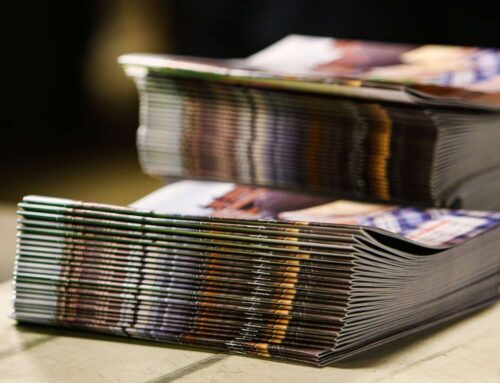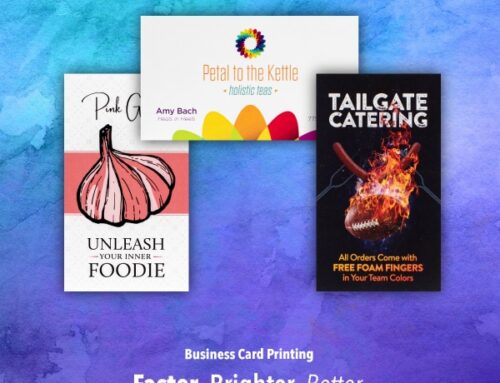Saddle stitch binding is a widely used and effective method for binding booklets, brochures, catalogs, manuals, and various other publications.
One fact that needs to be mentioned right away is that only an experienced saddle stitch printing service in Sparks, NV can bring your paper documents to life.
As you delve into the world of saddle stitch binding, one crucial aspect to consider is the page count.
Selecting the right page count for saddle stitch binding is paramount to achieving optimal results and ensuring your marketing materials stand out.

Table of Content
Understanding Saddle Stitch Binding
Factors Influencing Saddle Stitch Binding Page Count
Recommended Page Count Ranges
Tips for Optimal Results
Common Mistakes to Avoid
Understanding Saddle Stitch Binding
Before getting to the best page count for saddle stitch binding, let’s take a moment to understand what saddle stitch binding is.
Saddle stitch binding involves folding sheets of paper and stapling them together along the spine. This process creates a booklet with a neat and professional appearance. It is known for its simplicity, cost-effectiveness, and ability to produce a flat, easy-to-read booklet.
The term “saddle stitch” refers to the stapling method, where the pages are draped over a saddle-like device during the binding process. The folded sheets are nested inside each other and stapled along the folded edge.
As far as the saddle stitch binding page count is concerned, this binding method is ideal for booklets with relatively fewer pages, typically ranging from 8 to 64 pages. For larger page counts, you might want to consider services for perfect bound books in Reno.
Factors Influencing Saddle Stitch Binding Page Count
If you’re wondering which page count is best for saddle stitch, read on to learn about the key factors that come into play when determining this.
Paper Type and Thickness
Consider the weight and texture of the paper to ensure it aligns with your desired page count and overall booklet aesthetics. The type and thickness of paper play a significant role in determining the suitable page count for saddle stitch binding. Thicker papers can result in a bulky booklet, limiting the number of pages that can be comfortably bound together.
Saddle Stitching Machinery Limitations
Saddle stitch machinery has its limitations when it comes to accommodating a specific page count. Understanding these limitations is crucial for achieving optimal results. Some machines may struggle with very thin or thick booklets, affecting the binding quality. Working within the machinery’s capabilities ensures a smooth and efficient binding process.
Purpose of the Booklet
The purpose of your booklet also determines what page count is best for saddle stitch. For marketing brochures, concise and visually appealing content is often preferred, suggesting a lower page count for saddle stitch binding. On the other hand, informational catalogs or manuals might require a higher saddle stitch binding page count to accommodate detailed content without compromising readability.
Recommended Page Count Ranges
Small Booklets
A page count ranging from 8 to 16 pages is recommended for small booklets, like brochures. This is probably the best page count for saddle stitch binding of small booklets. It allows for a concise presentation of key information while maintaining a sleek and professional appearance.
Medium-Sized Booklets
So, what page count is best for saddle stitch when it comes to medium-sized booklets, such as catalogs or manuals? The count here can comfortably range from 16 to 32 pages. This provides sufficient space for comprehensive content without compromising the effectiveness of saddle stitch binding.
Larger Publications
Larger publications like magazines or event programs can extend the page count to 48 or even 64 pages. However, it’s essential to strike a balance between the desired content and the limitations of saddle stitch binding to ensure a durable and visually appealing final product.
Impact on Print Quality
It’s essential to consider the aesthetic appeal while balancing functionality. The page count in saddle-stitched booklets can significantly impact print quality.
When determining which page count is best for saddle stitch, you’ll need to remember one rule: as the page count increases, the thickness of the booklet also increases, potentially leading to a less polished appearance along the spine.
To maintain high print quality, particularly with larger page counts, choose a higher-quality, lighter-weight paper. This ensures the booklet remains flexible and the pages align neatly. Additionally, paying attention to the design and layout can help distribute content evenly, minimizing the impact on the binding.
Tips for Optimal Results
Achieving the best page count for saddle stitch binding comes down to doing things right from the get-go.
Design Considerations for Different Page Counts
You can tailor your design to the specific page count by ensuring a logical flow of information. For smaller booklets, focus on impactful visuals and concise text. Medium-sized booklets allow for more detailed content, while larger publications provide opportunities for in-depth storytelling and a variety of visuals.
Maintain a Cohesive and Engaging Layout
Regardless of the page count, maintain a cohesive layout throughout the booklet. Consistent branding, font choices, and color schemes contribute to a professional appearance. Ensure that each page serves a purpose and contributes to the overall message of the booklet.
Common Mistakes to Avoid
It is important to steer clear of the following two common saddle stitch binding mistakes.
Overloading with Content
One common mistake is attempting to include too much content in a limited space. Avoid overloading your booklet with information, as it can negatively impact readability and diminish the overall impact of your message. Prioritize key information and consider supplementing with online resources or additional printed materials if necessary.
Ignoring Binding’s Physical Limitations
Ignoring the physical limitations of saddle stitch binding machinery can lead to disappointing results. Attempting to bind too many pages or using extremely thick paper may strain the binding process, resulting in a less polished and possibly defective finished product.
Conclusion
Selecting the best page count for saddle stitch binding is a critical aspect of producing effective marketing materials. Whether you’re creating brochures, catalogs, manuals, or event programs, understanding the factors influencing page count and following recommended ranges ensures optimal results. Paying attention to design considerations, avoiding common mistakes, and balancing print quality with functionality will contribute to the success of your saddle-stitched booklets.
At Digiprint, we are committed to providing superior saddle stitch binding services in Reno. We’ll help bring your vision to life with precision and outstanding quality. Call us at 775-786-4464 or fill out our online form to start exploring your printing options.




